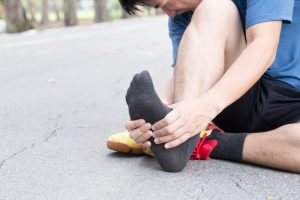
Plantar Fasciopathy
Why is your heel painful?
Most people probably couldn’t tell you where the plantar fascia is, but pain in this area of the foot is quite a common issue that we treat. If you want to know exactly where your plantar fascia is and what you can do to look after it, or if you’ve got an unexplained pain in your foot that you want to understand, this might clear a few things up.
Where is the plantar fascia?
The plantar fascia is the thick band of tough tissue that connects your heel bone to your toes. When you push off with your foot to take a step, this band tightens to increase the arch height and create a lever to propel you forward.
This is a very common area to experience pain – and one in ten people will suffer from what we call ‘plantar fasciopathy’ at some point in their lifetime.
What is plantar fasciopathy?
Plantar fasciopathy is an umbrella term for different problems that can impact the plantar fascia.
Plantar fasciitis

If the plantar fascia becomes acutely inflamed, this is a condition called plantar fasciitis (‘itis’ = inflammation in scientific talk). This is most common in runners, and accounts for around 10% of runner-related injuries. The repetitive movement of the foot in running, particularly when you run on hard surfaces, makes this band of tissue highly susceptible to overuse. New runners who try to do too much too soon, or those who suddenly change their running regime, can also excessively strain or tear the plantar fascia.
Plantar fasciosis
This is a degenerative condition, which is caused by the plantar fascia deteriorating under repetitive stress. It’s almost like a second stage plantar fasciitis, where if you leave the initial symptoms untreated, the condition can progress to a chronic issue where degeneration of the tissues is the main feature. Any cause of a plantar fascia problem that develops from an acute to a chronic stage can fall under the label of plantar fasciosis. Just like running can cause fasciitis, it too can lead a person into fasciosis if left for too long. Other causes include being sedentary, overweight and regularly wearing high heels for prolonged periods. People who have excessively flat or arched feet are also at risk of developing these problems.
What are the symptoms of plantar fasciopathy?
Whichever type of plantar fasciopathy you have, you are likely to experience similar symptoms. These include:
- Heel pain, particularly when walking after a long period of inactivity (a classic symptom includes pain on taking those first steps in the morning after waking from sleep)
- Tenderness in the heel area
- Difficulty bringing your toes towards your shin
- Pain when climbing stairs or walking on hard surfaces
If the pain in your foot occurs shortly after a sudden increase in activity, then it’s very likely to be plantar fasciopathy. But, let us take a look at you and we will be able to let you know exactly what is happening.
The Plantar fasciopathy is most common in people aged between 45 and 65 and is slightly more common in women than men. But anyone can experience it at any time.
How do we treat plantar fasciopathy?
If left untreated, plantar fasciopathy can cause pain for a very long time (most cases last at least six months). Because the pain can cause you to alter the way you walk, there is a chance of further, potentially more serious, damage being caused. So, it’s best to see a physiotherapist as soon as possible.
Some form of rest or alteration to your normal routine is important, particularly for plantar fasciitis. We’re likely to tell you to take a temporary break from running or other sports that may lead to continued excessive load being placed on the tissues, and ultimately, delayed healing.
We can massage the arch of the foot and other areas of the body including anywhere from the low back to the foot, to help relieve the pain and restore some movement. There are also a number of stretches and strengthening exercises that we can work with you on to help rehabilitate the plantar fascia and any other underlying causes.
We may also recommend shoe inserts, orthotics or night splints to support the area while it recovers.
In the vast majority of cases, treatment and time will be enough to combat the issue. However, in more severe cases, we may explore options such as shock-wave therapy and various types of injection into the local area of tissue. We will always aim to follow a conservative approach before making use of more invasive techniques.
If you think you might be suffering from plantar fasciopathy, or you want to avoid experiencing it in future, give us a call on (08) 9203 7771 ,email info@ngp.net.au and directly book an appointment to find out what we can do to help.
References
- Physiopedia. 2021. Plantar Fasciitis [Online] Available at: https://www.physio-pedia.com/Plantar_Fasciitis
- National Centre for Biotechnology Information. 2018. Plantar fasciopathy: a current concepts review [Online] Available at: https://www.ncbi.nlm.nih.gov/pmc/articles/PMC6134886/
- Podantics. 2021. What is the difference between plantar fasciitis and plantar fasciopathy? [Online] Available at: http://www.podantics.com.au/plantar-fasciitis-vs-plantar-fasciosis.html
